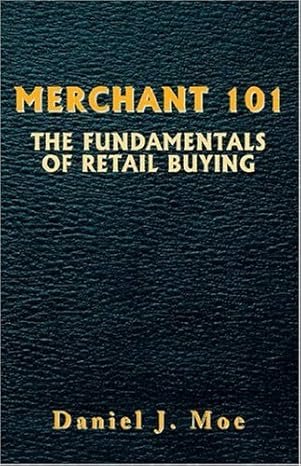
Merchant 101: A Deep Dive
Overview
Daniel J. Moe’s Merchant 101 is a concise yet comprehensive guide aimed at equipping aspiring and seasoned retailers with the fundamental principles of retail management.
The book presents a straightforward approach, focusing on practical advice rather than theoretical constructs.
Key Strengths
- Practical Orientation: Moe’s emphasis on real-world applications is a standout feature. He provides actionable insights into various aspects of retail operations, from inventory management to customer service.
- Concise and Focused: The book avoids unnecessary jargon and fluff, delivering essential information in a digestible format. This makes it a quick yet informative read.
- Holistic Perspective: While it covers a broad range of topics, Merchant 101 maintains a holistic view of retail, emphasizing the interconnectedness of different business functions.
- Emphasis on Customer Centricity: The book consistently underscores the importance of understanding and meeting customer needs, a core principle of successful retailing.
Areas of Focus
Merchant 101 covers a wide range of retail topics, including:
- Merchandising: Product selection, pricing, and presentation strategies are discussed in detail.
- Inventory Management: Moe provides practical tips for optimizing inventory levels and reducing stockouts.
- Customer Service: The book emphasizes the crucial role of exceptional customer service in building loyalty.
- Store Operations: Day-to-day operations, including staffing, scheduling, and visual merchandising, are covered.
- Financial Management: Basic financial concepts relevant to retailers are explained, such as profit margins, inventory turnover, and key performance indicators.
Target Audience
Merchant 101 is primarily geared towards small business owners and managers in the retail industry.
It is also a valuable resource for aspiring entrepreneurs considering a career in retail.
While the book provides a solid foundation, it may not delve deep enough into specific retail niches or advanced management techniques.
Potential Shortcomings
While Merchant 101 offers a strong foundation, it could benefit from:
- Deeper Dive into Specific Topics: Some readers may desire more in-depth coverage of particular areas, such as e-commerce or supply chain management.
- Case Studies: Real-world examples could enhance the book’s impact by illustrating how the concepts are applied in practice.
- Updates on Industry Trends: Given the rapidly changing retail landscape, incorporating the latest trends and technologies would strengthen the book’s relevance.
Overall Assessment
Merchant 101 is an excellent starting point for anyone involved in retail.
Its practical approach and clear writing style make it a valuable resource for both beginners and experienced retailers.
While it may not be an exhaustive guide, it provides a solid foundation for building a successful retail business.
Let’s Dive Deeper into Merchant 101
Here are some potential areas to focus on:
- Merchandising: Product selection, pricing, and visual merchandising strategies.
- Inventory Management: Techniques for optimizing stock levels and reducing costs.
- Customer Service: Building strong customer relationships and loyalty.
- Store Operations: Managing daily operations, staff, and store layout.
- Financial Management: Understanding key financial metrics and managing cash flow.
Merchandising
Moe provides a solid foundation in merchandising, emphasizing the importance of understanding your target customer and aligning product offerings accordingly.
He offers practical advice on product selection, pricing strategies, and the art of creating compelling product displays.
While the book doesn’t delve deep into advanced merchandising techniques, it serves as an excellent starting point for retailers.
Inventory Management
Merchant 101 effectively highlights the critical role of inventory management in retail success.
Moe discusses various inventory control methods, including ABC analysis and stock turnover ratios.
While the book doesn’t offer sophisticated inventory management models, it provides a clear understanding of the basics.
Customer Service
The author strongly advocates for exceptional customer service, emphasizing its role in building customer loyalty and driving sales.
The book offers practical tips on handling customer complaints, building relationships, and creating a customer-centric culture.
While the concept of customer service is well-covered, deeper insights into specific customer service strategies might be desired by some readers.
Store Operations
Merchant 101 offers a solid overview of store operations, covering topics such as staffing, scheduling, and store layout.
Moe emphasizes the importance of creating a welcoming and efficient store environment.
While the book provides a good foundation, it could benefit from more in-depth coverage of specific operational challenges, such as loss prevention or managing peak-hour traffic.
Financial Management
The book provides a basic understanding of key financial metrics relevant to retailers, including profit margins, inventory turnover, and sales per square foot.
While it doesn’t delve into complex financial analysis, it offers sufficient information for retailers to monitor their financial performance.
A more in-depth exploration of financial management tools and techniques would be beneficial for some readers.
Overall Assessment
Merchant 101 is a valuable resource for retail beginners and small business owners.
It offers a comprehensive overview of essential retail concepts and provides practical advice.
While the book may not be as in-depth as some specialized retail management textbooks, its concise and straightforward approach is a significant strength.
It serves as an excellent starting point for anyone seeking to build a solid foundation in retail management.


